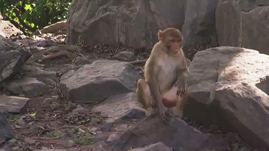Teachers' Domain - Digital Media for the Classroom and Professional Development
User: Preview

Source: The Human Spark: "So Human, So Chimp"




Major funding for The Human Spark is provided by the National Science Foundation, and by the Alfred P. Sloan Foundation. Additional funding is provided by the John Templeton Foundation, the Cheryl and Philip Milstein Family, and The Winston Foundation.
ALAN ALDA (NARRATION) Laurie and her students come frequently to this small Caribbean island. For some 70 years it’s been home to a lively population of rhesus monkeys maintained solely so that researchers can study their behavior in a natural setting.
Today, the plan is to demonstrate for us an experiment that has done much to convince even skeptics that monkeys have at least a working notion of other minds.
RESEARCHER Monkey! Monkey! Monkey, look!
ALAN ALDA (NARRATION) A monkey is tempted by two grapes. Both are placed on the ground – but only one human turns her back.
Almost every time Laurie Santos and her students have done this test, the result is the same: the monkey steals the grape from the person who isn’t looking.
The idea for the experiment came as much from the monkeys as from the researchers.
LAURIE SANTOS The embarrassing thing is it was a first hand experience of getting ripped off by a monkey. We’d had many of these unfortunate experiences of running these other studies that had food and so on, and we’d put a lemon to the side, write something in our notebook, and look back, and the lemon was running up a hill, being carried by a monkey. So we said, well, you know this is behavior they seem to do naturally. They seem to understand something. But what do they really understand about it. So that was how we got into using this behavior to really look at what they know about our perceptions and hopefully our mental states.
ALAN ALDA (NARRATION) Watch this monkey as he steals the grape from the person with her back turned. There’s no doubt the monkey is checking if he’s being watched. But does this mean he understands that he’s dealing with thinking beings?
LAURIE SANTOS We’re finding that the monkeys are very good about thinking about where eyes are pointed, and so on, but only in this really restricted context, so only in the context of stealing food from us. So one of the remarkable differences, and the things that the human species seems to be really good at, is actually applying these strategies more broadly.
ALAN ALDA (NARRATION) So Laurie’s research with monkeys suggests they have a glimmer of awareness of other’s minds. And Frans de Waal’s take on chimpanzee politics argues that the sort of social scheming they do suggests that, at least at the level of basic emotions, chimps too can see into each others’ minds.
 Loading Standards
Loading Standards